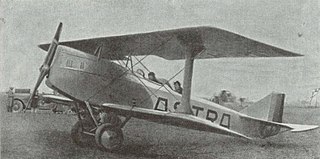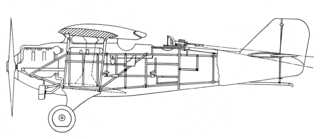
The Hispano-Suiza E-34, later renamed Hispano HS-34, was a Spanish single engine, tandem seat biplane, designed as a basic trainer. Twenty five were ordered by the Aeronáutica Naval, but only five had been completed when the Spanish Civil War intervened.

The TNCA Series C Microplano was a single-engine, single-seat fighter designed and built in Mexico during World War I.
The Wibault Wib 1, Wib C1 or, later, Wib 1 C1 was a French World War I single seat, single engine fighter aircraft prototype. Flown near the end of the war, it was not selected for production.
The Letov Š-13 was a single-seat, single-engine fighter aircraft designed and built in Czechoslovakia in the early 1920s. A biplane, it had aerodynamically thick wings which were originally cantilever structures, though interplane struts were later added. Only one was produced.

The Letov Š-14 was a single-seat, single-engine aircraft, designed and built in Czechoslovakia in the early 1920s. Originally intended as a biplane fighter, it was later modified into a monoplane and entered as a contestant in a speed competition.
The Dewoitine D.15 was a single-engine, single-seat biplane fighter aircraft built in France in the 1920s. Intended to offer structural simplifications when compared with monoplanes, it had a disappointing performance and was soon abandoned.
The Hanriot HD.20 was a French single seat shipboard fighter aircraft prototype completed in 1923. Only one was built.
The Potez 26 was a single seat fighter aircraft designed and flown in France in the mid-1920s. It did not reach production.
The Caudron C.97 was a two-seat biplane trainer designed and built in France around 1924. A number were used by the Bolivian Air Force.

The Caudron C.74 was a ten-seat, four engine passenger biplane built in France in 1922. It showed promise but the sole prototype crashed fatally in a competition and no more were completed.

The Caudron C.67 was a simple single seat biplane with a low powered engine. It was built and flown in France in 1922.

The de Marçay 2 C1 was a single seat biplane fighter designed in France and first flown in 1919. It did not go into production.

The SET 2 or Proto-SET 2 was a 1920s Romanian prototype reconnaissance and day-bomber aircraft.
The Weymann W-100, Weymann CTW-100 or Weymann W-100 RBL was a French three seat observation aircraft with a position for the observer within its partially glazed fuselage. Only one was built.

The Astra-Șeșefschi was a two-seat Romanian reconnaissance aircraft designed and built in 1923.
The Potez 24 A.2 was a mid-1920s French biplane intended to replace the Potez 15 as an army observation aircraft. The further improved and larger Potez 25 was preferred for production.

The Bréguet 25 or XXV was a French two seat fighter from 1925. It was heavily armed, carrying seven machine guns.

The Raab-Katzenstein RK.9 Grasmücke (Hedge-sparrow) was a 1920s German two-seat touring, advertising and training biplane. It was one of many designs from several countries aiming to provide low cost flying and was quite successful, with about twenty built.

The Blériot-Spad S.45 was a large, four engine French airliner which appeared at the 1921 Paris Salon. It could carry fifteen passengers or be adapted as a bomber.

Pierre Levasseur's first aircraft, the Levasseur PL.1, was a three seat tourer with a novel, simplified structure. One of only two Levasseur powered civil designs, the sole example was completed in 1922.












